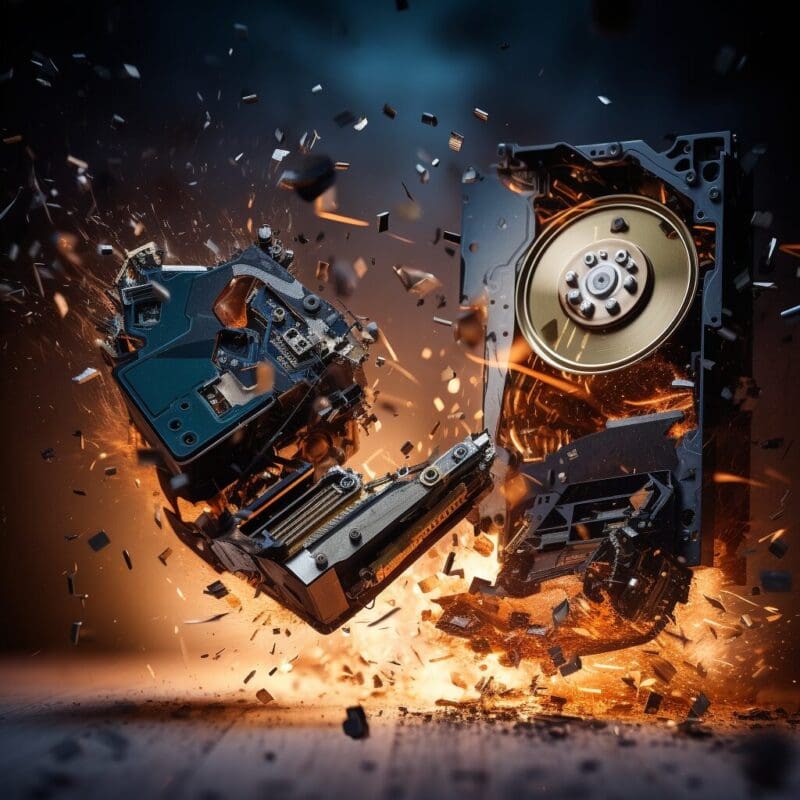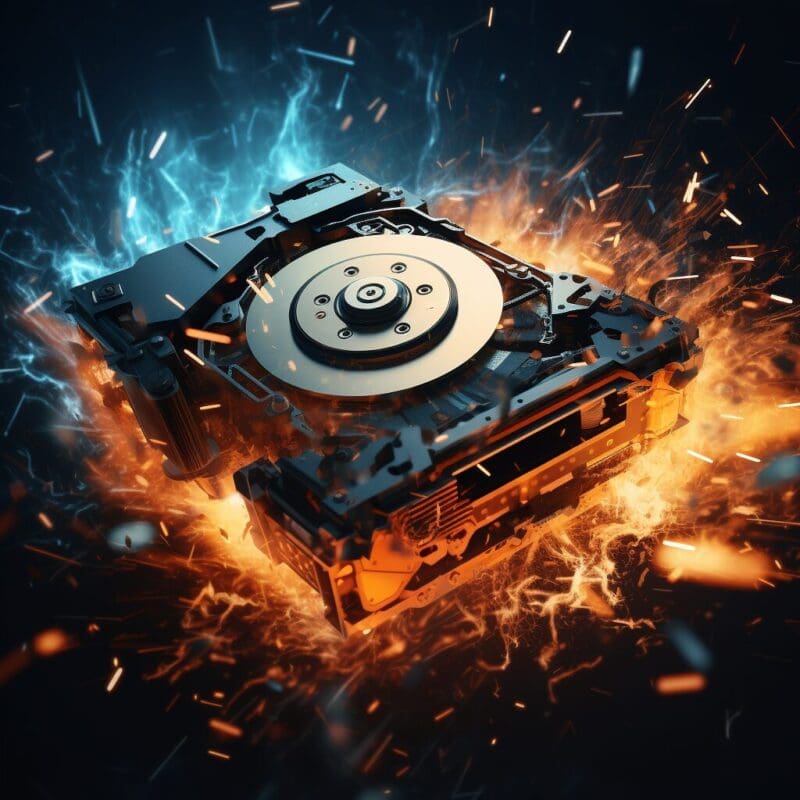So what is an SSD or an HDD?
In the digital age, the storage solutions you choose can significantly impact the performance and efficiency of your computer system. Whether you are a gamer seeking seamless experiences, a professional working with resource-intensive applications, or a casual user looking to store a plethora of memories and data, understanding the nuances of storage devices is pivotal. At the heart of this discussion are two prominent storage solutions: Solid State Drives (SSD) and Hard Disk Drives (HDD).
Definition of SSD and HDD
SSDs and HDDs are the brains behind your computer’s storage system, holding onto precious data, from the operating system to your favorite photographs. While HDDs have been around for a longer time, utilizing magnetic storage and mechanical parts to read and write data, SSDs are a more recent innovation, leveraging flash memory to offer faster and more reliable performance.
Brief on the Evolution of SSD and HDD Technology
Over the years, both SSDs and HDDs have undergone remarkable transformations. HDD technology matured, enhancing its storage capacity and reducing costs, making it a go-to solution for bulk storage needs. On the other hand, SSDs have revolutionized speed and efficiency, with advancements in technology mitigating earlier issues of limited lifespan and higher costs.
The Importance of Choosing the Right Storage Device
Your choice between an SSD and an HDD can influence not just the speed and storage capacity, but also the lifespan, reliability, and even the physical noise your system makes during operation. It is a decision that extends beyond mere preference, intertwining with your computing habits, the nature of tasks you undertake, and the depth of your pockets.
As we delve deeper into this guide, we will unravel the intricacies of SSDs and HDDs, laying out a detailed comparison to help you make an informed decision. From understanding the core functioning of these drives to exploring their pros and cons in various scenarios including gaming, security, and more, we aim to equip you with the knowledge to choose the storage solution that aligns perfectly with your needs.

Understanding SSDs
In the ever-evolving landscape of technology, Solid State Drives (SSDs) have emerged as a powerhouse, offering a range of benefits that can significantly enhance your computing experience. Let’s delve deeper to understand what SSDs are and the unique features they bring to the table.
Definition and Explanation of How SSDs Work
SSDs represent a modern approach to data storage, utilizing flash memory to store data. Unlike HDDs, they don’t rely on moving parts, which eliminates the risks associated with mechanical failures. The core of an SSD is its controller equipped with software, known as firmware, which orchestrates the operation of storing and retrieving data from its memory chips.
Benefits of Using SSDs
Speed
SSDs are renowned for their speed, drastically reducing boot times and loading data at a pace that can transform your computing experience. Whether it’s launching a resource-intensive application or transferring large files, SSDs ensure that you spend less time waiting and more time working or playing.
Durability
Thanks to their non-mechanical nature, SSDs are more durable and resistant to physical damage. They are shock-resistant, making them a reliable choice, especially for laptops that are prone to bumps and falls.
Energy Efficiency
SSDs consume less power compared to HDDs, which not only reduces energy costs but also offers the added benefit of less heat generation, thereby enhancing the lifespan of your computer.
The Downside of SSDs
While SSDs offer a plethora of benefits, they come with their own set of drawbacks.
Cost
SSDs are generally more expensive than HDDs, especially as you scale up in storage capacity. This higher cost per gigabyte can be a deterrent for users with budget constraints.
Data Recovery Challenges
In the event of a failure, recovering data from SSDs can be more complex and costly compared to HDDs. Moreover, SSDs use a method known as TRIM to manage deletions, which, while enhancing performance, makes data recovery post deletion nearly impossible.
Understanding HDDs
Before SSDs entered the scene, Hard Disk Drives (HDDs) were the primary choice for data storage. Despite the advent of SSDs, HDDs continue to hold a significant place in the market. Let’s delve into the world of HDDs to understand their workings, benefits, and limitations.
Definition and Explanation of How HDDs Work
HDDs operate on a fundamentally different mechanism compared to SSDs. They rely on magnetic storage, utilizing a series of rotating disks, also known as platters, to read and write data. A read/write head on an arm accesses the data while the platters are spinning, a mechanical process that defines the operational dynamics of HDDs.
Benefits of Using HDDs
Cost-Effectiveness
One of the standout benefits of HDDs is their cost-effectiveness. They offer a lower cost per gigabyte, making it possible to get large storage capacities without burning a hole in your pocket.
Data Recovery
In the unfortunate event of a drive failure, data recovery options are generally more straightforward and potentially successful with HDDs compared to SSDs. This is partly because they do not use the TRIM function, which makes data recovery post deletion a feasible option.
The Downside of HDDs
While HDDs have their merits, they come with a set of drawbacks that are important to consider.
Speed
HDDs generally offer slower data transfer speeds compared to SSDs. This is evident in longer boot times and slower file transfers, which can be a significant downside, especially for users who require quick access to large volumes of data.
Fragility
Due to their mechanical nature, HDDs are more susceptible to physical damage. A sudden jolt or drop can cause the read/write head to touch the platter, leading to potential data loss and damage, a phenomenon known as a head crash.

SSDs and HDDs: A Detailed Comparison
When it comes to choosing between SSDs and HDDs, understanding the detailed nuances can be the key to making an informed decision. In this section, we dissect various aspects ranging from speed to power consumption, offering a comprehensive view of both storage solutions.
Speed
Booting Time
SSDs significantly outperform HDDs in booting time, offering a swift startup that can be a boon for users who are constantly on the move.
File Transfer Speed
When it comes to transferring large files, SSDs take the lead again, ensuring that you save precious time, which can be particularly beneficial for professionals working with large datasets.
Game Loading Time
For the gaming enthusiasts, SSDs offer reduced game loading times, enhancing the gaming experience with smooth and fast transitions.
Lifespan
Average Lifespan
While SSDs were initially criticized for a shorter lifespan, technological advancements have led to improved durability, bringing them at par with HDDs in terms of lifespan.
Wear and Tear
HDDs, with their mechanical parts, are more prone to wear and tear over time, while SSDs, devoid of moving parts, offer a robust performance with lesser degradation over time.
Reliability
Durability in Different Environments
SSDs offer a higher tolerance to physical shocks and adverse environmental conditions, making them a more reliable choice, especially for laptops.
Security and Data Recovery
While HDDs offer better prospects for data recovery in case of failures, SSDs provide a more secure environment, reducing the chances of data corruption.
Capacity
Storage Capacity Options
Both SSDs and HDDs offer a wide range of storage capacities, catering to different user needs. However, HDDs generally provide larger storage options at a more affordable price point.
Price per Gigabyte
HDDs win in terms of cost-effectiveness, offering a lower price per gigabyte, which can be a decisive factor for users with substantial storage needs and budget constraints.
Cost
Market Trends in Pricing
While SSDs have been traditionally more expensive, the gap in pricing has been narrowing over the years, with SSDs becoming increasingly affordable.
Price Comparison with Examples
In a subsequent section, we will provide specific examples to offer a clear picture of the current market trends in the pricing of SSDs and HDDs.

Gaming
Game Loading Time Comparison
As mentioned earlier, SSDs offer a superior gaming experience with reduced loading times, a factor that can be crucial for avid gamers.
The Future of Gaming
With SSDs becoming a standard in gaming consoles, the future of gaming seems to be leaning towards SSDs, promising faster and smoother gaming experiences.
Noise
Noise Generation in HDDs
HDDs, with their mechanical parts, tend to generate noise during operation, which can be a disturbance in quiet environments.
Silence of SSDs
In contrast, SSDs operate silently, offering a noise-free environment, which can be a significant advantage for users seeking tranquility during their computing sessions.
Power Consumption
Energy Efficiency of SSDs
SSDs are more energy-efficient compared to HDDs, which not only saves on power but also results in lesser heat generation, thereby enhancing the overall lifespan of your system.
Impact on Battery Life
For laptop users, SSDs can be a boon, offering extended battery life compared to systems equipped with HDDs, ensuring that you remain unplugged for a longer duration.
SSD and HDD Form Factors
As we navigate the complex landscape of storage solutions, understanding the different form factors of SSDs and HDDs can be pivotal. These form factors not only dictate the physical dimensions of the drives but also influence their compatibility with various systems. Let’s explore the diverse range of form factors available in the market today.
Evolution of SSD Form Factors
Over the years, SSDs have seen a transformation in their form factors, evolving to meet the demands of modern computing systems. Initially starting with the same size as traditional HDDs to fit into existing systems, SSDs have now branched out into smaller and more compact designs, including M.2 and U.2 form factors, which allow for seamless integration into a wide variety of devices, including ultra-thin laptops and high-performance desktops.
M2 SSDs and Compatibility with Motherboards
M.2 SSDs have become increasingly popular, offering not only compact sizes but also enhanced performance. However, it is essential to ensure compatibility with your motherboard, as M.2 drives come in both SATA and NVMe interfaces, with the latter offering significantly higher speeds. Understanding the specifications of your system can help in choosing an M.2 SSD that leverages the full potential of your setup.
Hybrid Computers: Combining SSD and HDD
In recent years, we have seen the emergence of hybrid solutions that combine the strengths of both SSDs and HDDs. These systems typically use SSDs for storing the operating system and frequently used applications, ensuring fast boot times and swift application launches, while relying on HDDs for bulk storage, offering a cost-effective solution to meet substantial storage needs.
2.5 and 3.5-inch HDDs
Traditionally, HDDs have been available in 3.5-inch form factors for desktops and 2.5-inch form factors for laptops. While these remain popular, the advent of SSDs has led to a gradual decline in the usage of 3.5-inch HDDs, with many users preferring the speed and reliability of SSDs for their primary drives.
Making the Right Choice
In the vast sea of storage solutions, making the right choice between an SSD and an HDD can often feel like navigating through uncharted waters. However, armed with the knowledge of the intricacies of both storage devices, you can make a choice that aligns perfectly with your needs, preferences, and budget. Let’s explore how to go about making this crucial decision. Once you have made the right choice, make sure you know how to install a hard drive.
Who Should Choose an HDD and Why
If you are a user with substantial storage needs, working with large files and requiring a cost-effective solution, an HDD could be your go-to option. Moreover, if data recovery options are a priority for you, HDDs offer a more straightforward pathway to retrieving data in case of failures. It is a tried and tested solution, offering reliability and a lower cost per gigabyte.
Who Should Choose an SSD and Why
On the other hand, if speed is of the essence for you, be it in booting times or file transfers, an SSD should be your choice. SSDs are particularly beneficial for gamers seeking reduced loading times and professionals working with resource-intensive applications. Moreover, if you are a laptop user, the enhanced durability and energy efficiency of SSDs can be a significant advantage, offering a robust and reliable performance.
How to Find Out if Your Computer Has an SSD or an HDD
If you are unsure about the type of drive your system houses, there are simple ways to find out. On Windows, you can use the Device Manager or the Disk Management tool to identify your drive type. On Mac, navigating to “About This Mac” and then “System Report” will provide you with the necessary details. Understanding your current setup can be the first step in deciding whether to stick with your existing solution or make a switch to a different storage device.

How To Maintain A Hard Drive
Once you have made your choice between an SSD and an HDD, the next crucial step is to ensure its longevity and optimal performance through regular maintenance. Let’s delve into the essential tools and tips that can help you keep your drive in top shape.
The Importance of Maintaining Your Drive
Maintaining your drive is not just about ensuring a long lifespan; it is about safeguarding your precious data. Regular maintenance helps in identifying potential issues before they escalate, ensuring the smooth functioning of your system.
Tools and Tips for Keeping Your Drive Clean and Efficient
Regular Backups
Whether you opt for an SSD or an HDD, regular backups should be a part of your maintenance routine. It ensures that your data is safe, even in the event of a drive failure.
Disk Cleanup and Optimization Tools
For Windows users, tools like Disk Cleanup can help in removing unnecessary files, freeing up space, and optimizing the performance of your drive. Similarly, Mac users can utilize the built-in Disk Utility tool for maintenance tasks.
Firmware Updates
Especially for SSD users, keeping the firmware updated is essential. It not only enhances performance but also fixes bugs, ensuring a stable and secure environment.
Defragmentation (For HDDs)
For HDD users, defragmenting the drive periodically can be beneficial. It helps in rearranging the files for optimal performance. However, this is not recommended for SSDs, as it can lead to unnecessary wear and tear.
Monitoring Software
Utilizing monitoring software can help in keeping a tab on the health of your drive, alerting you to potential issues before they become major problems.
Conclusion
As we reach the end of this comprehensive guide, it is time to recap the vital points and offer some final thoughts on choosing between SSDs and HDDs.
Recap of the Key Differences Between SSDs and HDDs
We embarked on this journey with a deep dive into the worlds of SSDs and HDDs, exploring their workings, benefits, and limitations. While SSDs dazzled with their speed, durability, and energy efficiency, HDDs held their ground with cost-effectiveness and simpler data recovery options.
We delved into a detailed comparison, dissecting various aspects from speed to power consumption, and explored the different form factors, helping you to understand the compatibility with various systems.
Final Thoughts on Making the Choice Between SSD and HDD Based on Individual Needs and Budget
As we stand at the crossroads, the choice between an SSD and an HDD boils down to individual needs and budget. If you are seeking a fast, reliable, and modern storage solution, leaning towards an SSD would be beneficial. Conversely, if your priority lies in obtaining larger storage capacities without stretching your budget, an HDD could be your ally.
In a rapidly evolving technological landscape, hybrid solutions combining the strengths of both SSDs and HDDs are also emerging as a viable option, offering a balanced approach to speed and storage capacity.
As you make your choice, remember that maintaining your drive can go a long way in ensuring a smooth computing experience, safeguarding your data, and enhancing the lifespan of your storage solution.





